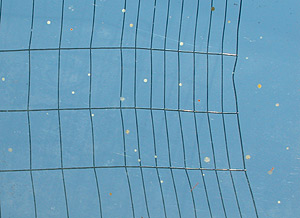 For the first time this month, temperatures on the roof rose to about 50 degrees F, and the girls took flight. It was a day of much work for them, I think, as well as a bit of a release and relief.
For the first time this month, temperatures on the roof rose to about 50 degrees F, and the girls took flight. It was a day of much work for them, I think, as well as a bit of a release and relief.First the more cold-tolerant Carniolans of the Wilde colony appeared, and then (a few degrees later) the Italian bees of Twain made their December debut. They cleared their doorsteps of many dead sisters, and then took to the air.
Bees (unless they are sick) do not relieve themselves inside the hive, so they retain waste until they can get outside. During these cold days, it can be weeks between "cleansing flights." One of the medications that they got this Fall (Fumagilin-B) was meant to help them with the stress of all this: it chews on bacteria that like to live in a honeybee's gut. The picture above shows dots of bee poo on one of our skylights. A master beekeeper once assured me that the stuff stinks like crazy if you get it on you.
It seems that they also come out thirsty. There were bees parked at the edge of the puddles on the roof (we had unbelievably cold, nasty rain just yesterday), sucking up water. There was one swimmer – a worker who may have been swept into the water by an sudden breeze – so I got to sit in the sun with a drying bee for a while.
It's colder than when I did bee-resuscitation during the summer, and the honeybee cranked up a bit like a cold engine. They usually run their front legs over their antennae alot and stick out their tongues while they dry off, but instead of a methodical and furious wringing and patting, this bee engaged in a kind of ssssllllooowww m-ohhhhhh-tion groooom that suddenly sped up when the sun hit her. It seemed really mechanical, but it was just the reality of being a cold blooded life form. Her eyes went from dull to active, and she took off without so much as a backward glance, as bees are wont to do. I hope I see her come Spring.
No comments:
Post a Comment